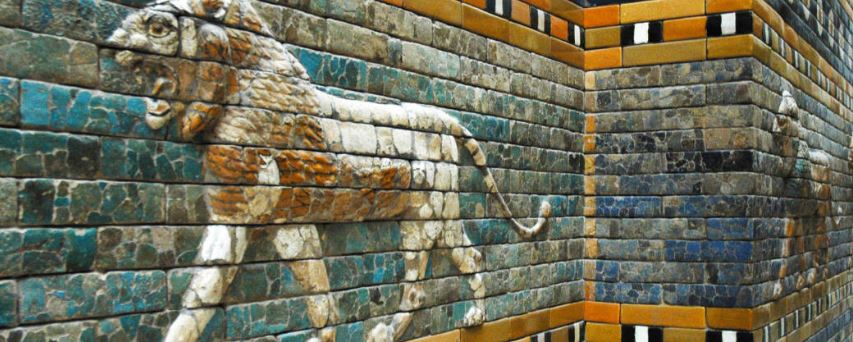Visitors are Stunned Visiting the Pergamon Museum

The Gate of Ishtar at the Pergamon Museum
Chilling. For more than 2,000 years the Ishtar Gate has stood for the Immorality and corruption of Babylon. The Old Testament depicts it as an evil city. The Tower of Babel, a symbol of human arrogance, began there. Located between the Tigris and Euphrates in what today is Iraq, Babylon was largely rebuilt by Nebuchadnezzar in the 6th Century BC. At its peak, with more than 200,000 inhabitants, it was the largest metropolis in the world.
Symbol of Ancient Babylon’s Magnificence
Enter the hall at the The Pergamon Museum in Berlin and it will stand before you. The gate will be your most moving visual experience.
The Old Testament describes its overwhelmingly opulent temples, shrines and palaces. Symbolic of all of that splendor was a visitor’s first introduction to the city: the monumental Gate of Ishtar, built in 575 BC out of enameled bricks, in cobalt blues and sea greens, decorated with reliefs of 575 dragons and bulls. Nebuchadnezzar had the limestone gate inscribed with these words, “I placed wild bulls and ferocious dragons in the gateways and thus adorned them with luxurious splendor so that people might gaze on them in wonder.” The captive Israelites were most likely escorted by their captors to the city by this very gate.
Biblical Relevance
The Bible mentions Babylon more than 280 times. To understand this prominence, you need to know something about Babylonian history and culture. While museum curators at the Pergamon Museum have the Gate of Ishtar and the other artifacts on display as a way to preserve Iraq’s cultural heritage, we value them because of their context of the Jewish people and the Old Testament.
Nebuchadnezzar was strategic in his several military campaigns designed to increase Babylonian influence in what is now known as Syria and Judah. Each time his soldiers moved into new territory, they enslaved the population and plundered its treasures. In 587 BC, Nebuchadnezzar and his armies plundered Jerusalem. Solomon’s Temple was destroyed and the city was razed to the ground. Only a few people were permitted to remain to tend to the land. Most of the elite were taken into captivity.
“And Nebuchadnezzar of Babylon carried out from there all the treasures of the house of the LORD and the treasures of the king’s house, and he cut in pieces all the articles of gold which Solomon king of Israel had made in the temple of the LORD, as the LORD had said. Also he carried into captivity all Jerusalem: all the captains and all the mighty men of valor, ten thousand captives, and all the craftsmen and smiths. None remained except the poorest people of the land.” 2 Kings 24:13-14
Tour Bible History and the Landscape of Christianity
The Pergamon Museum is visited by approximately 1,135,000 people every year, making it the most visited art museum in Germany, and is one of the largest in the country. Viewing the ancient relics from biblical times at this beautiful, historical museum is one of many relevant and exciting excursions that may be included in the Reformation tour.
Interested in learning more about these artifacts and historical relevance? Join us on a Reformation tour, to learn about this as well as the Castle Church, Luther’s hiding places, homes of Dietrich Bonhoffer, John Calvin, the Anabaptists, the famous Wartburg Castle (where Luther was imprisoned), Coburg Fortress, Augustinian Monastery, Johann Sebastian Bach’s church, and Merneptah Stele, the earliest known writings that mention Israel as a nation located in the Berlin Museum, and more. Check availability here: Reformation tours of Switzerland and Germany.
